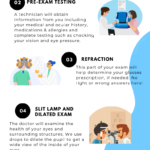By Feyi Aworunse, OD, FAAO

April 13, 2022
Doctors’ offices, including our own, can be anxiety-inducing. Visits to your office trigger a stress response in some patients. A more relaxed patient can better work with you to ensure a high-quality exam, and may be more likely to stick around after the exam to learn about the products you sell in your office.
Here’s what I do in my practice to ease patient anxiety.
Show Empathy
Empathy is the ability to understand and share the feelings of another person emotionally. This is a widely researched aspect of the provider-patient relationship. It has been shown to positively impact the experience of the patient and doctor and improve clinical outcomes.
I greet the patient with warmth. I make eye contact, listen to and observe the patient, noting anxiety. I ask the patient questions about themselves, show respect and interest in them as a person first, not just as a patient.
Taking a moment to acknowledge the patient’s anxious behavior or feelings can offer us an opportunity to address the source of the anxiety. Anxiety may be driven by internal or external stressors. For instance, some patients may not be anxious about the exam itself, but rather, events beyond our control as providers, such as a crisis they are experiencing in their life.
If the anxiety is exam-related, ask what makes them nervous about the exam:
● How are you feeling? Is there anything on your mind that you want us to address before we get started with the exam?
● Are you afraid of a potential diagnosis? Needing glasses? Dilation? Is it fear of something getting close to your eyes?
Asking these questions enables you to educate the patient enough to quell their fears or pivot when the stressor cannot be overcome. Some patients may have had poor experiences with other providers. This serves as a teachable moment for us to make the best of their experience with us and our staff.
A recent patient came to my office seeking a second opinion on a diagnosis. I noticed she was fidgety in the reception area, so I called her back into an exam room to wait until a technician was ready to get her started. I introduced myself to the patient and asked, “How are you feeling today?” She came right out with, “I’m OK, just a bit nervous.”
When I asked her what was making her nervous, she said she was nervous about what I was going to find in her eyes. She told me about a previous doctor who found something “suspicious” in her eyes and referred her to another provider for further testing. Her insurance coverage changed during the transition of care, so the patient had spent the past several months wondering what was wrong with her eyes. I took a moment to reassure her that I understood her concerns about the unknown, and that she and I were going to work together to find answers and create a plan for care.
I visibly saw the sense of relief in her body language, and she verbalized her gratitude. And all of this was before we even began the exam.
Empathy goes a long way toward validating the patient’s feelings and concerns. The anxious patient may at first seem like an inconvenience, especially during a busy clinic day. Taking a moment to pause and see the person in front of you, and attempting to understand why they may be anxious, goes the distance. In my experience, it not only helps the patient, but it helps me as well.

An infograpic Dr. Aworunse developed herself to give patients guidance on what exactly to expect when they visit her office.
Show & Tell, Then Do
For each step of the exam, I explain what instrument I am about to use and what I am about to do. I tell them why I am doing these things, and then proceed with the task after asking, “May I begin?” or “Do you have any questions before I begin?”
Sometimes patient anxiety and apprehension are rooted in a perceived lack of control over what is going to happen to them. We forget that the environment we work in, the tools and terminology we use every day, are foreign to the average person. It can be intimidating coming into an environment you don’t understand.
By informing the patient of what and why we are doing a certain task, explaining the tools and instruments, and only then doing the procedure, helps keep the patient informed throughout their experience.
Equipment (i.e. slit lamp, tonometer, phoropter, visual field machine) used during an exam can be intimidating, so:
● Explain what is being used and for what purpose
● Clearly state what will happen before you do it
● Ask, “Do you have any questions before I proceed?”
There is a particular anxiety associated with manifest refraction. We’ve all experienced patients who fear “getting it wrong.” I find that this fear stems from the patient not wanting to “mess up” their prescription. Some fear they may need a glasses prescription and don’t want to end up with glasses at all.
I reassure the patient that there are no wrong answers. I say something like, “Your vision relies on your eyes and brain working together. There are no right or wrong answers. Only you know what looks best to you. I’m relying on you to tell me what you see. Let me know if I need to slow down or if you would like to see anything again.”
Prepare the Patient Ahead of Their Appointment
My practice prepares the patient in advance by providing them with information about our practice, the provider(s) and staff, and what to expect during their visit.
Make sure your practice website is up to date with relevant information, such as location, parking and contact information. Include photos and/or videos of your office, staff and providers.
Make patient intake forms available online, so the patient can complete them before arriving.
Some patients’ fear and anxiety relate to being in an unfamiliar environment or navigating the healthcare system. Informing patients of what to expect ahead of time is especially helpful for patients who are new to the practice. Informing the patient of what to expect on the day of and during appointments can lessen the fear of the unknown.
Create a “What to expect during your visit” video, printed handout and scripted statement for staff during scheduling or the appointment confirmation call.
Give patients an opportunity to have their questions answered prior to their visit. Consider an FAQ handout or section on your website. Depending on how much you want to invest in digital and print media, costs can be minimal or significant. Consider this an investment in marketing and practice-branding. In an information-driven society, photos and videos of your practice allow you to reach potential patients before they make an appointment or set foot in your practice.
Other Articles to Explore
Bottom Line: Realize Some Patients Are Anxious & Address Their Concerns
There are many factors that influence a patient’s level of comfort during their office visit. The strategies mentioned above are just a few ways to create meaningful experiences that not only benefit the patient, but the practice too. By being proactive, we have the opportunity to engage with patients in a way that may change their perception of healthcare and potentially reduce instances where patients do not seek care because of fear or unfavorable experiences in the past.
 Feyi Aworunse, OD, FAAO, practices at the Eye Clinic at Nashville General Hospital at Meharry. To contact her: feyi.aworunse@gmail.com
Feyi Aworunse, OD, FAAO, practices at the Eye Clinic at Nashville General Hospital at Meharry. To contact her: feyi.aworunse@gmail.com

























